Manu Saraswat
@manusaraswat.bsky.social
Postdoc in ML for genomics with Dana Pe'er and Oliver Stegle
Previously at Genentech, UBC and BITS Pilani
https://scholar.google.com/citations?user=4yUtALcAAAAJ&hl=en&oi=ao
Previously at Genentech, UBC and BITS Pilani
https://scholar.google.com/citations?user=4yUtALcAAAAJ&hl=en&oi=ao
All the best @paubadiam.bsky.social 🎉🎉
June 23, 2025 at 11:46 AM
All the best @paubadiam.bsky.social 🎉🎉
Thanks for your thoughts
May 22, 2025 at 12:33 PM
Thanks for your thoughts
I am genuinely wondering and curious what you think. It’s increasingly hard to see how academia can attract or retain top talent with offers like this, especially when industry offers 2–3x more. Something structural has to change if we’re serious about advancing AI in science.
May 22, 2025 at 9:20 AM
I am genuinely wondering and curious what you think. It’s increasingly hard to see how academia can attract or retain top talent with offers like this, especially when industry offers 2–3x more. Something structural has to change if we’re serious about advancing AI in science.
Hi Andrea,
Thanks for sharing this, it’s an exciting and meaningful opportunity. But to be honest, the listed salary (€42–49k for postdocs) is deeply misaligned with the qualifications you're asking for- post-PhD experience, publications in top AI and biology journals, teaching, and vision.
Thanks for sharing this, it’s an exciting and meaningful opportunity. But to be honest, the listed salary (€42–49k for postdocs) is deeply misaligned with the qualifications you're asking for- post-PhD experience, publications in top AI and biology journals, teaching, and vision.
May 22, 2025 at 9:20 AM
Hi Andrea,
Thanks for sharing this, it’s an exciting and meaningful opportunity. But to be honest, the listed salary (€42–49k for postdocs) is deeply misaligned with the qualifications you're asking for- post-PhD experience, publications in top AI and biology journals, teaching, and vision.
Thanks for sharing this, it’s an exciting and meaningful opportunity. But to be honest, the listed salary (€42–49k for postdocs) is deeply misaligned with the qualifications you're asking for- post-PhD experience, publications in top AI and biology journals, teaching, and vision.
Thanks a lot for the shoutout Stein. scDORI builds upon the insights from the foundational works in GRN inference from your lab - Cistopic, SCENIC, SCENIC+
Thanks a lot for your contributions. Very exciting time to be in the field 🚀
Thanks a lot for your contributions. Very exciting time to be in the field 🚀
May 16, 2025 at 10:10 AM
Thanks a lot for the shoutout Stein. scDORI builds upon the insights from the foundational works in GRN inference from your lab - Cistopic, SCENIC, SCENIC+
Thanks a lot for your contributions. Very exciting time to be in the field 🚀
Thanks a lot for your contributions. Very exciting time to be in the field 🚀
Thanks to all our collaborators, specially @lauraruedag.bsky.social who co-led the computational analysis and was the best partner in crime one could ask for. What a delight it was!
Thanks to Elisa, Tannia and Fani for leading the experimental aspects.
Thanks to Elisa, Tannia and Fani for leading the experimental aspects.
May 16, 2025 at 10:05 AM
Thanks to all our collaborators, specially @lauraruedag.bsky.social who co-led the computational analysis and was the best partner in crime one could ask for. What a delight it was!
Thanks to Elisa, Tannia and Fani for leading the experimental aspects.
Thanks to Elisa, Tannia and Fani for leading the experimental aspects.
14/ We believe this approach can be applied to other cancers to uncover—and exploit—plasticity brakes. Get in touch if interested! #GBM #MultiOmics #CancerResearch #deeplearning #cancerneuroscience #GRNs #Cancer #singlecell
May 16, 2025 at 10:05 AM
14/ We believe this approach can be applied to other cancers to uncover—and exploit—plasticity brakes. Get in touch if interested! #GBM #MultiOmics #CancerResearch #deeplearning #cancerneuroscience #GRNs #Cancer #singlecell
13/ Want to learn more? Read our regulatory paper www.biorxiv.org/content/10.1... and companion spatial multi-omics study www.biorxiv.org/content/10.1...
Watch out for thread from @bayraktarlab.bsky.social on mapping conserved spatiotemporal trajectories of GB
Watch out for thread from @bayraktarlab.bsky.social on mapping conserved spatiotemporal trajectories of GB

Decoding Plasticity Regulators and Transition Trajectories in Glioblastoma with Single-cell Multiomics
Glioblastoma (GB) is one of the most lethal human cancers, marked by profound intratumoral heterogeneity and near-universal treatment resistance. Cellular plasticity, the capacity of cancer cells to t...
www.biorxiv.org
May 16, 2025 at 10:05 AM
13/ Want to learn more? Read our regulatory paper www.biorxiv.org/content/10.1... and companion spatial multi-omics study www.biorxiv.org/content/10.1...
Watch out for thread from @bayraktarlab.bsky.social on mapping conserved spatiotemporal trajectories of GB
Watch out for thread from @bayraktarlab.bsky.social on mapping conserved spatiotemporal trajectories of GB
13/ Our framework unifies regulatory and spatial logic of GB heterogeneity. While our companion paper showed subclones are intermixed across conserved tissue niches, our regulatory model explains WHY—they follow the same trajectory because they're constrained by the same regulatory rules!
May 16, 2025 at 10:05 AM
13/ Our framework unifies regulatory and spatial logic of GB heterogeneity. While our companion paper showed subclones are intermixed across conserved tissue niches, our regulatory model explains WHY—they follow the same trajectory because they're constrained by the same regulatory rules!
12/ Beyond chromatin changes, MYT1L transformed GB cells into less aggressive neuronal-like cells with: • Enhanced neurite-like morphology • Reduced tumor microtube connectivity • Decreased proliferation • In vivo: slower growth, less invasion, longer survival!

May 16, 2025 at 10:05 AM
12/ Beyond chromatin changes, MYT1L transformed GB cells into less aggressive neuronal-like cells with: • Enhanced neurite-like morphology • Reduced tumor microtube connectivity • Decreased proliferation • In vivo: slower growth, less invasion, longer survival!
11/ Our experimental validation was striking: • MYT1L overexpression closed >80% of differential chromatin regions • MYT1L knockout reopened access to plastic fates • MYT1L directly bound and repressed regulators of other GB states• 85% of scDORI's predicted TF targets confirmed!
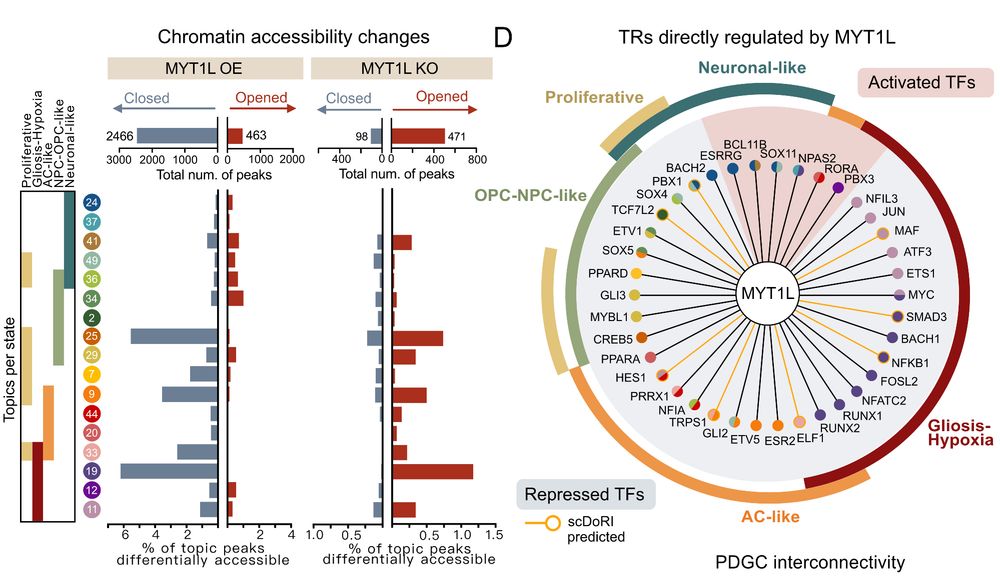
May 16, 2025 at 10:05 AM
11/ Our experimental validation was striking: • MYT1L overexpression closed >80% of differential chromatin regions • MYT1L knockout reopened access to plastic fates • MYT1L directly bound and repressed regulators of other GB states• 85% of scDORI's predicted TF targets confirmed!
10/ 🔥 Can we use these GRNs to manipulate tumor identity and push GB cells into less plastic states? YES! We predicted MYT1L as the key regulatory bottleneck—a master repressor that locks cells into neuronal-like states by directly binding and suppressing the regulators of plastic states.

May 16, 2025 at 10:05 AM
10/ 🔥 Can we use these GRNs to manipulate tumor identity and push GB cells into less plastic states? YES! We predicted MYT1L as the key regulatory bottleneck—a master repressor that locks cells into neuronal-like states by directly binding and suppressing the regulators of plastic states.
9/ Remarkably, our regulatory roadmap explains tumor architecture! States with easy transitions exist in close spatial proximity, while states separated by regulatory barriers are spatially distant. The regulatory rules we've uncovered directly shape how tumors are organized!
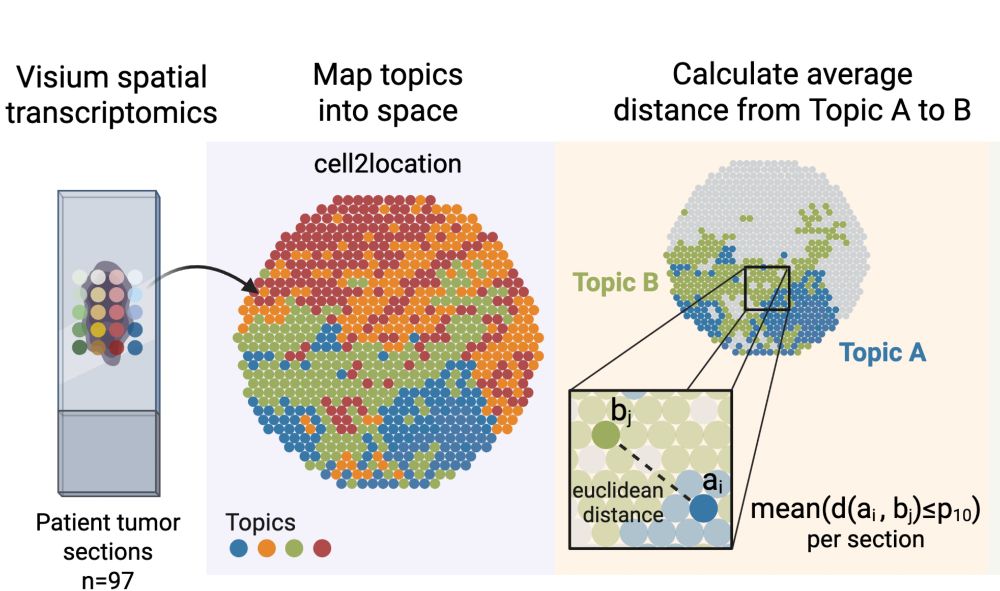

May 16, 2025 at 10:05 AM
9/ Remarkably, our regulatory roadmap explains tumor architecture! States with easy transitions exist in close spatial proximity, while states separated by regulatory barriers are spatially distant. The regulatory rules we've uncovered directly shape how tumors are organized!
8/ This roadmap revealed striking asymmetry in GB plasticity: • OPC/NPC-like and AC-like states can easily activate multiple alternate fates • Neuronal-like states are "locked" by strong repression barriers • Transitions follow preferred directions (OPC→Neuronal easier than Neuronal→OPC)
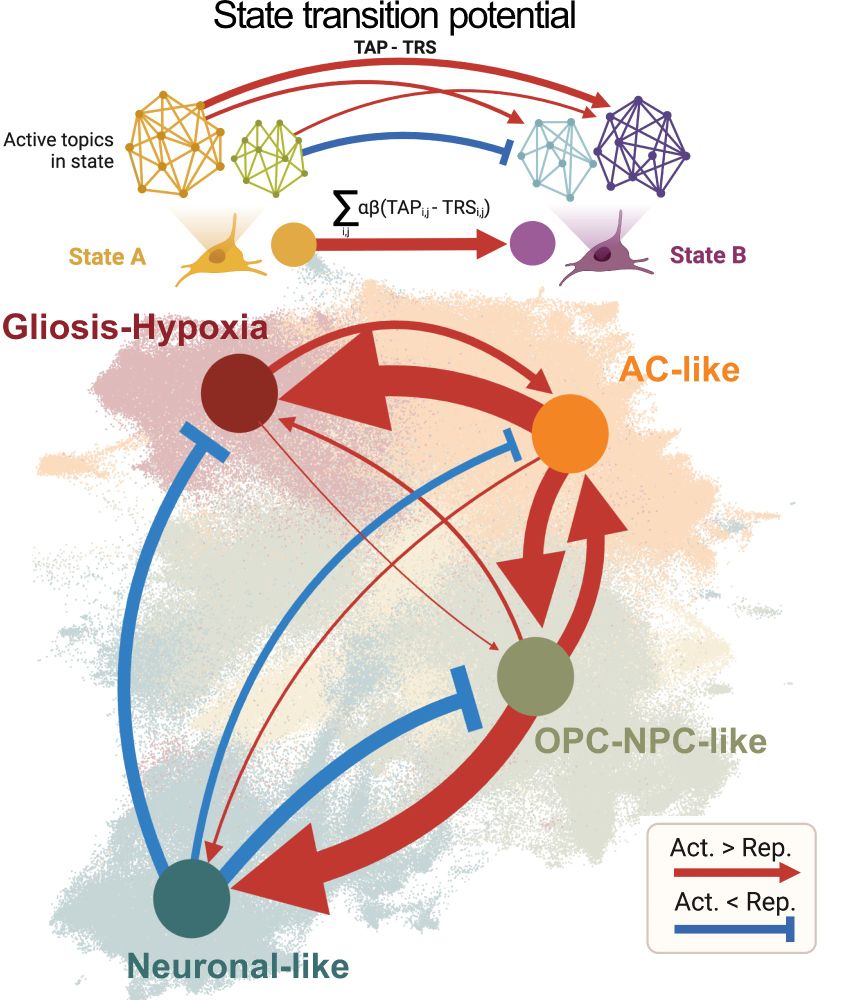
May 16, 2025 at 10:05 AM
8/ This roadmap revealed striking asymmetry in GB plasticity: • OPC/NPC-like and AC-like states can easily activate multiple alternate fates • Neuronal-like states are "locked" by strong repression barriers • Transitions follow preferred directions (OPC→Neuronal easier than Neuronal→OPC)
7/ 🔑 The big question: Which tumor states can easily transition to others? We developed metrics to quantify both activation potential (what enables transitions) and repression barriers (what prevents them), creating the first regulatory roadmap of GB plasticity.
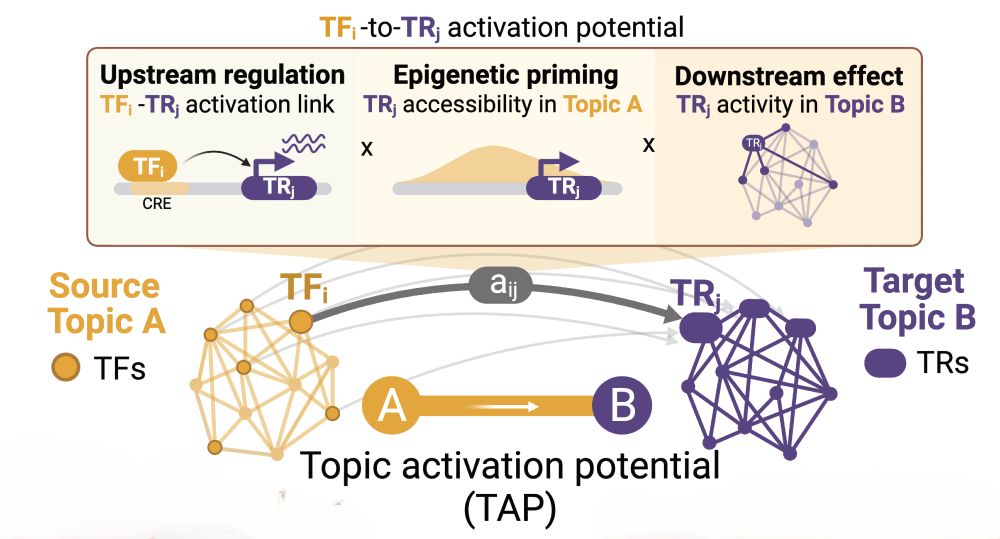
May 16, 2025 at 10:05 AM
7/ 🔑 The big question: Which tumor states can easily transition to others? We developed metrics to quantify both activation potential (what enables transitions) and repression barriers (what prevents them), creating the first regulatory roadmap of GB plasticity.
6/ The power of multi-omics: We can distinguish what a cell IS versus what it COULD BECOME. While only 16% of Topic Regulators are expressed across different tumor states, over 54% are epigenetically accessible—revealing "primed drivers" ready for activation during transitions!
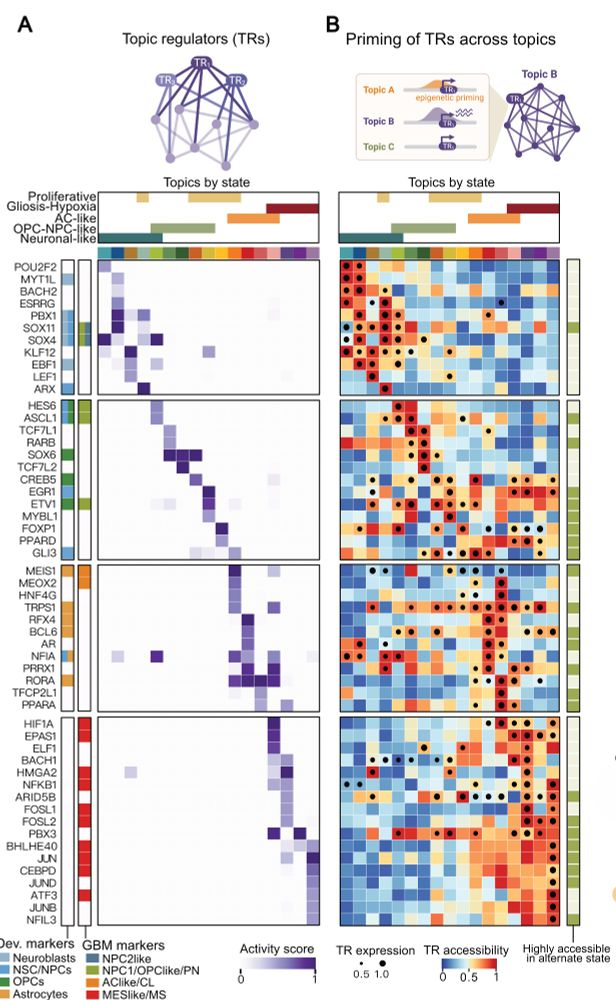
May 16, 2025 at 10:05 AM
6/ The power of multi-omics: We can distinguish what a cell IS versus what it COULD BECOME. While only 16% of Topic Regulators are expressed across different tumor states, over 54% are epigenetically accessible—revealing "primed drivers" ready for activation during transitions!
5/ Applied to GB, scDORI uncovered Topics that redefine tumor heterogeneity through regulatory logic. Each Topic links specific TFs, enhancers, and target genes that work together across tumor states. We identified key "Topic Regulators" (TRs)—master TFs for each Topic.
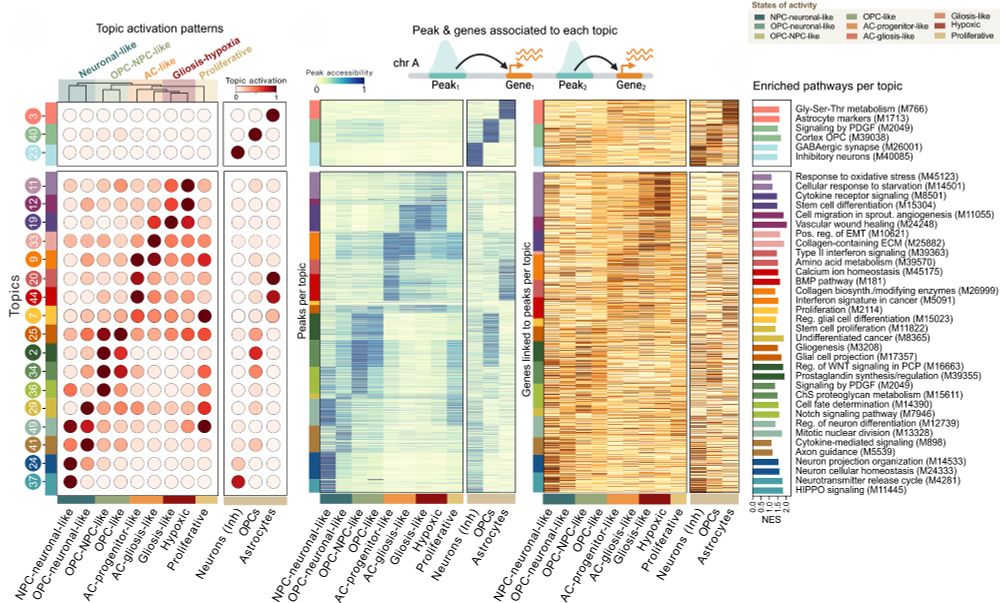
May 16, 2025 at 10:05 AM
5/ Applied to GB, scDORI uncovered Topics that redefine tumor heterogeneity through regulatory logic. Each Topic links specific TFs, enhancers, and target genes that work together across tumor states. We identified key "Topic Regulators" (TRs)—master TFs for each Topic.
4/ scDORI: • Scales to millions of cells • Models continuous cell state GRNs • Incorporates both activation AND repression signatures • Each cell is modeled as a mixture of regulatory Topics • Can be applied to ANY multi-omic dataset (happy to hear your feedback, separate 🧵 on soon!)
May 16, 2025 at 10:05 AM
4/ scDORI: • Scales to millions of cells • Models continuous cell state GRNs • Incorporates both activation AND repression signatures • Each cell is modeled as a mixture of regulatory Topics • Can be applied to ANY multi-omic dataset (happy to hear your feedback, separate 🧵 on soon!)

